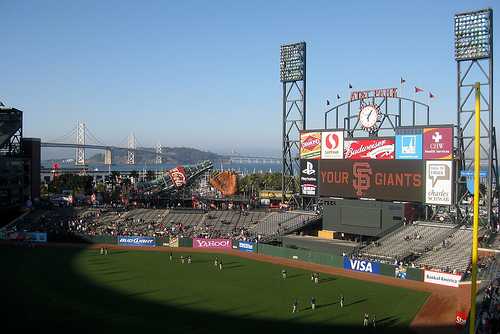 San Francisco’s AT&T Park is one of several professional sports stadiums saving energy and money by going green.Photo: Wally GobetzCross-posted from Amanda Little’s blog at Forbes.com.
San Francisco’s AT&T Park is one of several professional sports stadiums saving energy and money by going green.Photo: Wally GobetzCross-posted from Amanda Little’s blog at Forbes.com.
As the San Francisco Giants celebrate their 2010 World Series triumph, they’re quietly coveting another, humbler feat — one that’s perhaps no less historic in the long run. The Giants are one of the greenest teams in professional sports, and they’re proving that sustainable practices fatten the bottom line even as they ease the burdens on the planet.
Their stadium, AT&T Park, which accommodates about 45,000 fans, runs its scoreboard on solar power, recycles and composts nearly 50 percent of its waste, sources eco-friendly napkins, containers, utensils, toilet paper, and the like, and has enough efficiency features to cut the stadium’s annual energy and water bills in half. That amounts to huge savings, given that stadiums can consume as much energy as small cities.
The Giants are on the front end of a trend that’s quickly gaining traction in Major League Baseball and the NFL and NBA. Teams are stepping up recycling and efficiency in their facilities, attracting lucrative corporate sponsorships with green messaging, and raising consciousness among fans. If the trend continues to build in the next two years, we may find that games do more to push environmental progress in the U.S. than politics.
Especially now, given the acrimony in Washington, professional sports may have a broader and more profound influence than any other single entity on American mindsets, slicing through socioeconomic and political divides. “More than 150 million Americans — half our population — regularly follow professional sports,” Allen Hershkowitz, senior scientist at the Natural Resources Defense Council (NRDC), told me. Hershkowitz founded the NRDC project greensports.org, a pro-bono consultancy that advises teams and leagues on sustainable strategies.
For nearly a century, professional sports have galvanized social movements and ginned up American patriotism. Baseball, for instance, desegregated a decade before the nation did, helping catalyze the civil rights movement. Women’s basketball and softball leagues were organized before women had the right to vote.
Today environmental advocacy is getting big play in ballparks, even though it’s facing crippling barriers in the Beltway. During the playoffs and throughout the World Series, Robert Redford loomed large on Jumbotrons. “The coming decade may be our last chance to head off environmental crises like global warming,” he intoned between innings in a public service announcement for the NRDC. “We can choose a different future. But we’ve got to do it quickly. And each of us must play a part.”
If you talk to team executives, they seem less interested less in the ethics of sustainability than in the economics.
“I’m not going to try and convince you that it’s all about altruism,” said Jason Pearl, the Giants’ managing vice president of corporate sponsorship and new business development. “This is very clearly a benefit to our bottom line.” The net positive isn’t just the savings on energy, water, and waste disposal, which will more than pay off the initial investment in efficiency measures. Pearl can leverage the Giants’ greening strategies to grow existing sponsorships and attract new ones.
PG&E, the utility that supplies power to two-thirds of California, worked with the Giants to retrofit their stadium, and then built a significant branding campaign around that effort. “They see us as a platform to execute their energy-efficient programming,” said Pearl. “At the same time, our fans are a great audience for advertising that effort.”
The Giants have also attracted or expanded green sponsorship deals with Canadian Solar, LINC Corporation (which provides heating and air conditioning), and Centerplate (a hospitality company that provides food to sports stadiums). It’s a virtuous circle. “We’ve been able to use green sponsorship dollars to drive opportunities that, in turn, attract more green sponsorship dollars,” said Pearl.
It might seem obvious to pursue this sort of strategy in markets like San Francisco, which has an exceptionally high Birkenstocks-per-citizen ratio. But similar stories of green branding success are emerging among teams in Atlanta, Boston, Houston, and other not-so-obviously-green markets.
The Boston Red Sox, which have begun converting their 100-year-old Fenway Park into a green stadium, have built green sponsorship deals with Waste Management, National Grid, and Poland Springs. “Poland had a bull’s eye on them in terms of the plastic bottles backlash,” said Troup Parkinson, the team’s vice president of client services, “so they came to us with a proposal to do a major recycling campaign at the park. It was a win-win — two forward-thinking brands working together.”
The Atlanta Braves, a team that has cut its energy bills by $350,000 a year with stadium retrofits, built a similar green partnership with Coca-Cola. The company placed giant recycling receptacles shaped like Coke bottles throughout Turner Field to collect the tens of thousands of PET bottles that are thrown away at each event; Coca-Cola then recycles those bottles into a synthetic fabric used to make the uniforms for 2,000 stadium staffers. These uniforms, bearing the dual logos of Coca-Cola and the Braves, also display a number indicating how many recycled bottles it took to manufacture the garment. The program has generated so much buzz among Braves fans that the team and Coca-Cola are discussing a merchandise line made from the stadium’s recycled bottles.
The list of green sponsorships extends well beyond baseball. In the NFL, the Philadelphia Eagles built a state-of-the-art green stadium that has saved more than $5 million in energy bills since 2005. The team also decided to source green products from its suppliers, and when its longtime partner Kimberly-Clark didn’t come up with the right offerings, the Eagles switched to SCA-Tork, maker of napkins, bathroom tissue, and other paper products. Not only does Tork now provide stadium supplies, it has signed on to a seven-figure sponsorship deal to advertise these efforts.
In the NBA, half a dozen teams including the Utah Jazz, the Portland Trailblazers, and the Phoenix Suns are developing state-of-the-art green facilities and, in turn, forging green marketing campaigns with sponsors ranging from Orbit Sprinkling Systems to Allied Waste. Some teams are also offering green incentives for fans such as ticket discounts for those who travel to the game via public transit.
The twin benefits of energy savings and sponsorships are good news in an industry that has been suffering from low ticket sales. Last year, Major League Baseball sold 1 million fewer tickets than it did in pre-recession 2007. The NFL and NBA have also seen sharp drops in their ticket revenues due to strained household budgets.
With this in mind, the greening trend in professional sports makes good sense — why wouldn’t a team want to cut its energy bills and seek alternative revenue streams during an economic downturn? As for potential sponsors, what company these days doesn’t want to green its image, whether it’s selling corn chips or cars?
And yet, for every green sporting stadium that’s being built, there are two more that are going in the opposite direction. The new Dallas Cowboys stadium, for instance, is an energy-guzzlin
g colossus averaging $200,000 in monthly utility bills and consuming about as much power as Santa Monica, Calif.. (A conventional scoreboard, on its own, can devour as much electricity annually as 100 homes.)
There’s certainly a long way for professional sports to go — only a small percentage of teams have joined the greening trend. And the strategies that have been pursued so far have glaring blind spots, such as fuel use. Sports teams have extensive travel schedules, covering as many as 34,000 miles in a season.
I asked representatives of the NFL, NBA, and MLB if their commissioners might consider mandating league-wide energy-efficiency practices: Could teams be required to cut the energy demands of their stadiums, just as they’ve been exhorted to participate in league-wide campaigns to fundraise for cancer research and fight childhood obesity? Could divisions be restructured so that teams play neighboring teams within set regions for most of the season, as they did long ago, slashing travel miles? All responded, in so many words, No.
At a time of federal paralysis on energy and climate legislation, our push for progress must happen from the ground up, in our schools, churches, cities, states — and sports teams.
Let’s applaud the pioneering teams that are greening professional sports. Let’s also encourage them to do more, and demand similar practices from those that have yet to join the movement. The reality is, we’re not getting positive environmental action from our elected leaders, but we might be able to get it from our players. For now anyway, they’re more popular than our politicians — and perhaps more influential.




